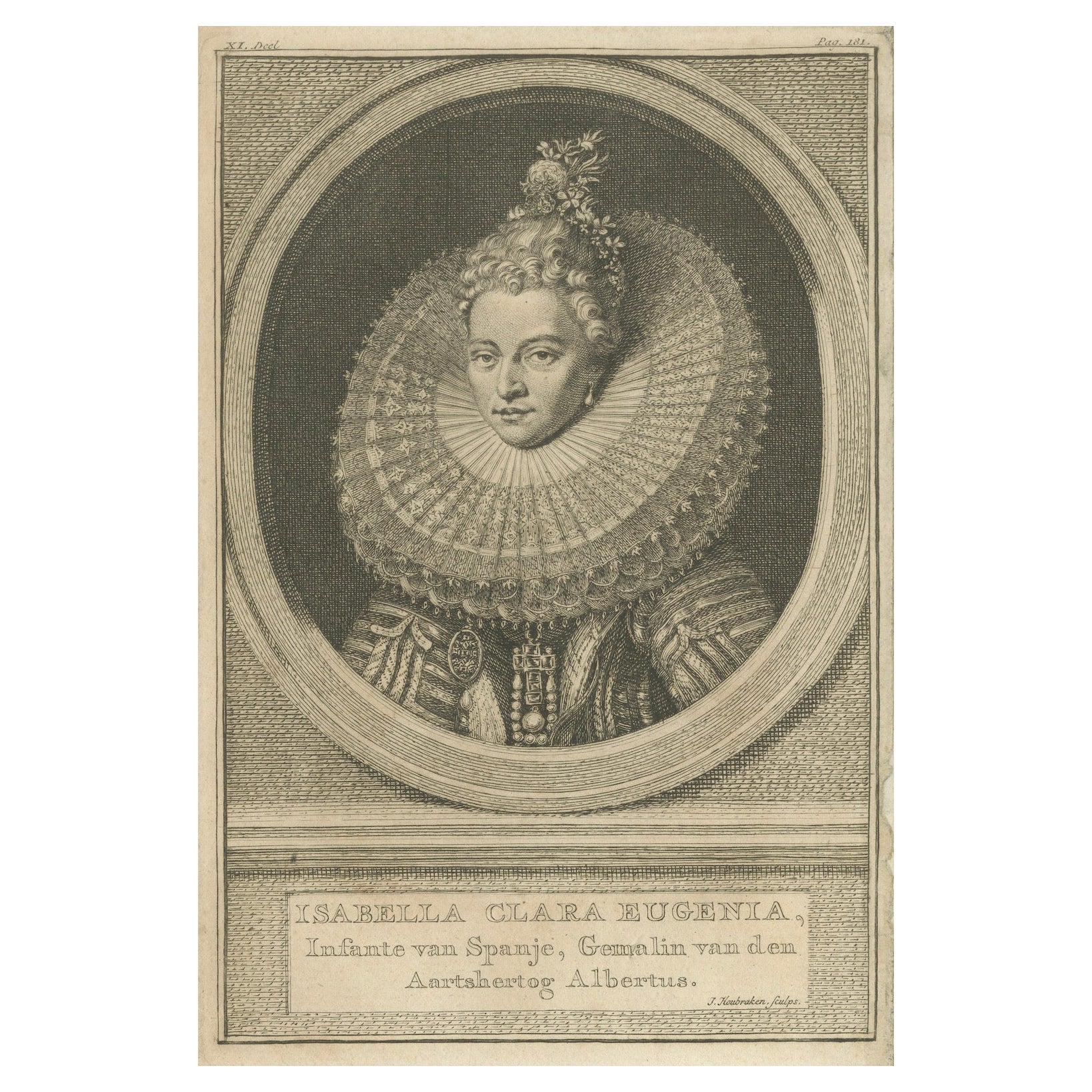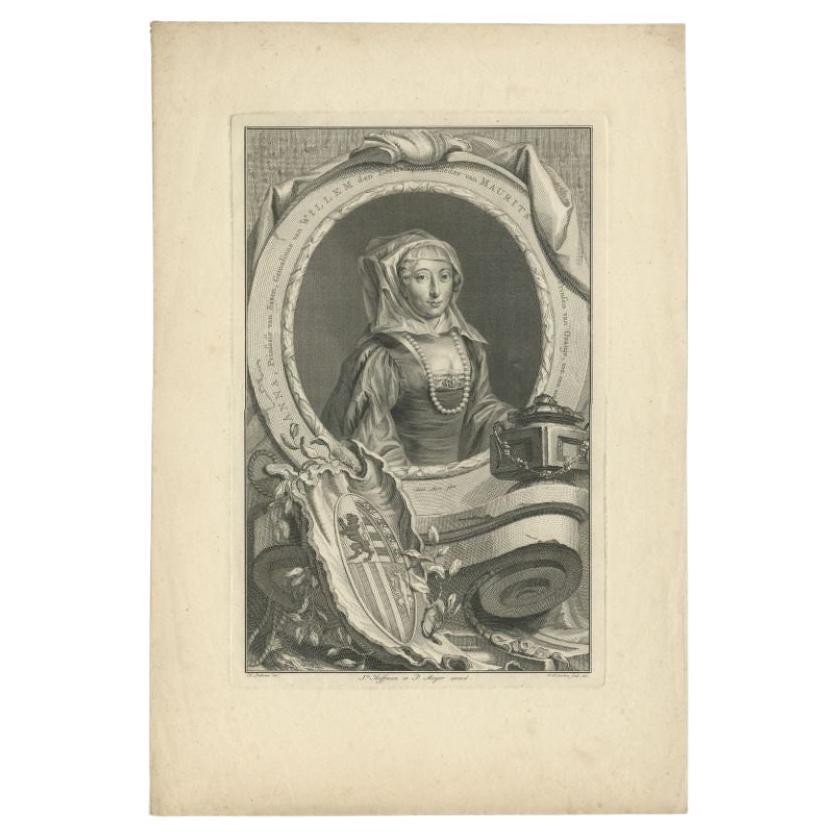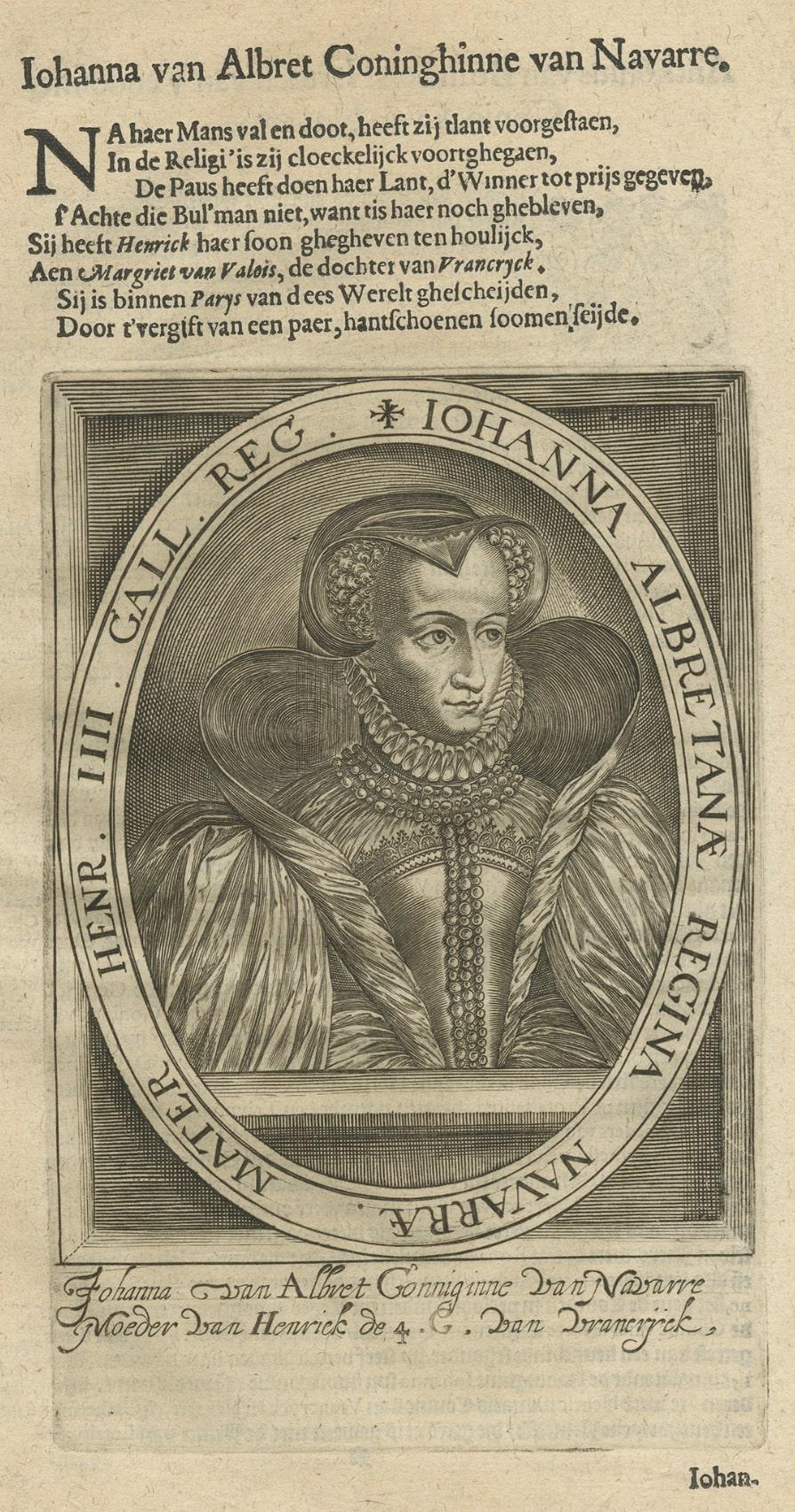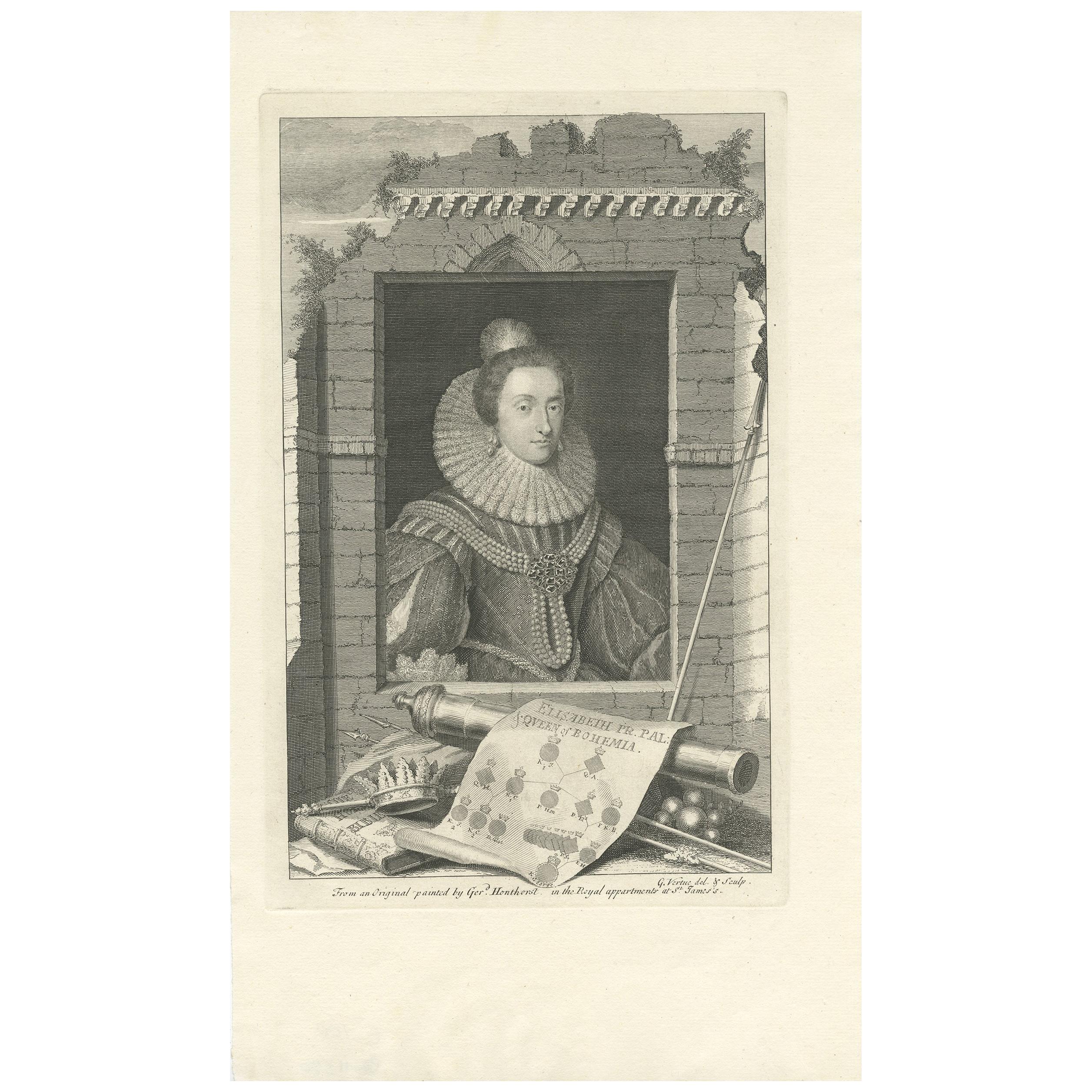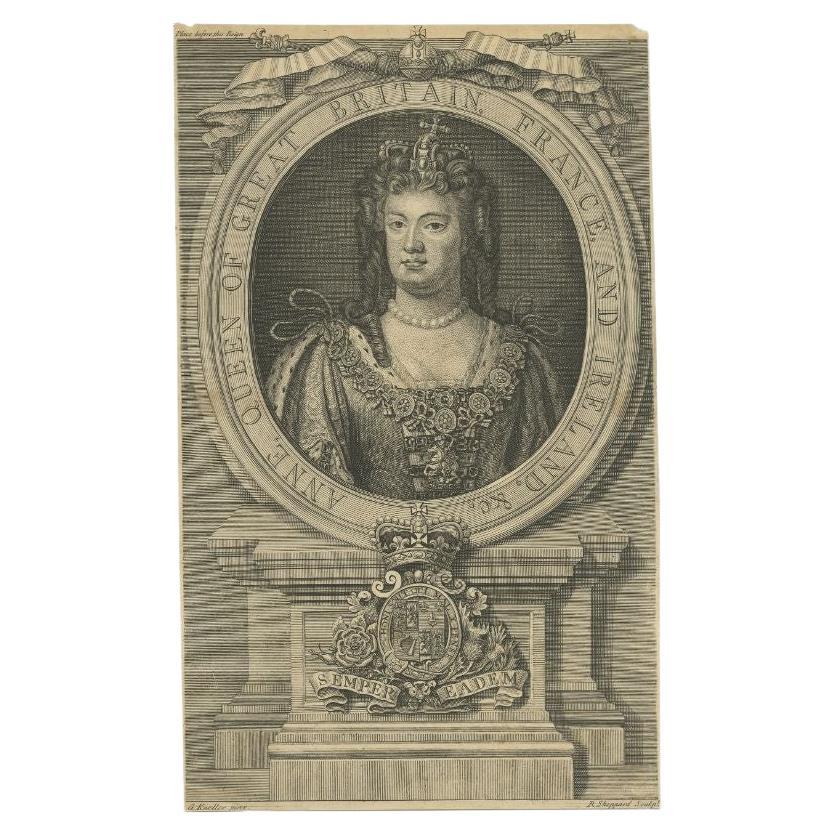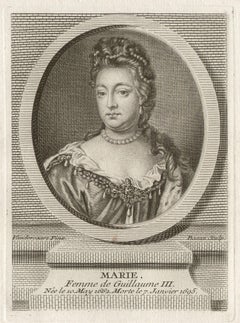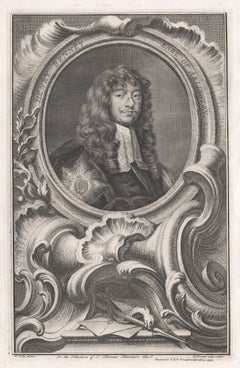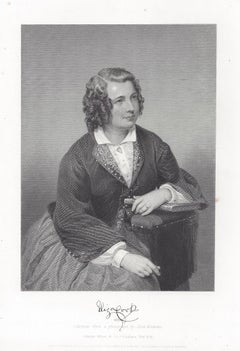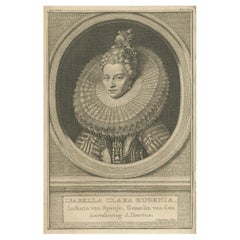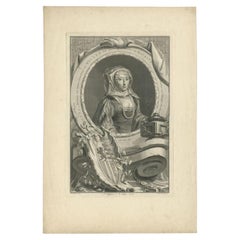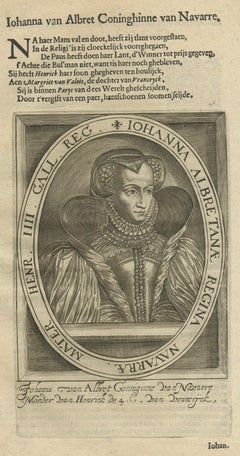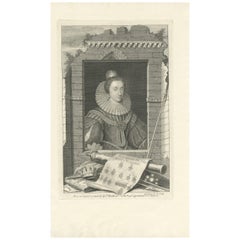Items Similar to Amelia Elisabetha, mid 17th century Flemish portrait engraving, 1651
Want more images or videos?
Request additional images or videos from the seller
1 of 6
Pieter de Jode II after Anselmus Van HulleAmelia Elisabetha, mid 17th century Flemish portrait engraving, 16511651
1651
$480
£367.29
€420.37
CA$677.89
A$736.75
CHF 394.83
MX$8,945.41
NOK 4,956.83
SEK 4,596.71
DKK 3,139.62
About the Item
Flemish portrait engraving, dated 1651, of Amalie Elisabeth of Hanau-Münzenberg (1602–1651), who was Landgravine consort and Regent of Hesse-Kassel. From a series of portraits of the Dignitaries at the Peace of Münster (Pacis Antesignani sive Icones legatorum).
Lettered in open letters around portraits: 'PVR ET LOYAL'. Lettered in cartouche below portrait: 'Amelia Elisabetha / ... / ... Nomine P.T. Regens.' and "Anselmus van Hulle pinxit. Petrus de Iode sculpsit" and "Accessit Priuilegium Cæsareum. Cum priuilegio Regum et Hollandiæ ordinum etc. 1651".
350mm by 250mm (platemark) 360mm by 258mm (sheet).
- Creator:Pieter de Jode II after Anselmus Van Hulle (Flemish)
- Creation Year:1651
- Dimensions:Height: 14.18 in (36 cm)Width: 10.16 in (25.8 cm)
- Medium:
- Movement & Style:
- Period:
- Condition:Thin margins. A couple of tiny marks.
- Gallery Location:Melbourne, AU
- Reference Number:1stDibs: LU1244213728012
About the Seller
5.0
Gold Seller
Premium sellers maintaining a 4.3+ rating and 24-hour response times
Established in 2005
1stDibs seller since 2019
631 sales on 1stDibs
Typical response time: 1 hour
- ShippingRetrieving quote...Shipping from: Melbourne, Australia
- Return Policy
More From This Seller
View AllQueen Mary, Queen of England, royalty portrait engraving, circa 1780
Located in Melbourne, Victoria
'Marie'
Copper-line engraving by Pierre Francois Basan (1723-1797) after Van der vaart.
Mary II (1662-1694) reigned as Queen of England, Scotland, a...
Category
Late 18th Century Renaissance Portrait Prints
Materials
Engraving
Lady Stanhope, English mezzotint portrait print after Sir Joshua Reynolds, c1780
By Joshua Reynolds
Located in Melbourne, Victoria
'The Honourable Lady Stanhope'
Anne Hussey (Delaval), Lady Stanhope (died 1811) was the wife of Sir William Stanhope of Whig Park.
James Watson (c1739-...
Category
Late 18th Century Naturalistic Portrait Prints
Materials
Engraving, Etching, Mezzotint
Henry Bennet Earl of Arlington, English Civil War, portrait engraving, c1820
By Jacobus Houbraken 1
Located in Melbourne, Victoria
Copper-line engraving by Jacobus Houbraken (1698-1780) after Peter Lely.
Houbraken was a Dutch engraver famous for his series of portraits of famous English historical figures with elaborate cartouches.
Originally published 1739, this impression c1820.
360mm by 230mm (platemark)
Henry Bennet, 1st earl of Arlington, 1618-85, was an English statesman who fought for the royalists in the English civil war...
Category
Early 19th Century Renaissance Portrait Prints
Materials
Engraving
Eliza Cook, English author and Chartist poet, antique portrait engraving print
Located in Melbourne, Victoria
'Eliza Cook'
Steel-engraving after a photograph by John Watkins, 1872. Facsimile signature below the image.
Eliza Cook (1818 - 1889) was an English author, Chartist poet and writer...
Category
Early 19th Century Victorian Portrait Prints
Materials
Engraving
Johann Jakob Scheuchzer, mezzotint portrait print
Located in Melbourne, Victoria
Johann Jakob Scheuchzer (1672 - 1733) was a Swiss traveller naturalist and geologist. His best known scientific works are his paleontological 'Lithographia Helvetica' (1726) and his 'Physica Sacra...
Category
Late 18th Century Naturalistic Portrait Prints
Materials
Engraving, Mezzotint, Etching
Frances Sargent Osgood, American poet, antique portrait engraving print, 1872
By Alonzo Chappel
Located in Melbourne, Victoria
'Frances Sargent Osgood'
Steel-engraving after the painting by Chappel. 1872. Facsimile signature below the image.
Frances Sargent Osgood (1811-1850) was an American poet and one of the most popular women writers during her time and was also famous for her exchange of romantic poems with Edgar Allan Poe.
Alonzo Chappel...
Category
Early 19th Century Victorian Portrait Prints
Materials
Engraving
You May Also Like
Antique Portrait Isabella Clara Eugenia – Etching by Houbraken, 18th Century
Located in Langweer, NL
Antique Portrait Isabella Clara Eugenia – Etching by Houbraken, 18th Century
This elegant 18th-century portrait depicts Isabella Clara Eugenia (1566–1633), Infanta of Spain and sove...
Category
Antique Mid-18th Century Dutch Prints
Materials
Paper
Antique Portrait of Anna of Saxony, Wife of William of Orange, 1757
Located in Langweer, NL
Antique portrait titled 'ANNA, Prinsesse van Saxen, Gemalinne van WILLEM den Eersten, Moeder van MAURITS Prinsen van Oranje, enz. enz. enz'. Portrait of Anna of Saxony, wife of William of Orange...
Category
Antique 18th Century Dutch Prints
Materials
Paper
Antique Portrait of Joan of Navarre, Queen of England, 1615
Located in Langweer, NL
Antique portrait titled 'Iohanna Albretanae Regina (..)'. Portrait of Joan of Navarre. This print originates from 'Tooneel der keyseren ende coningen van christenryck sedert den onde...
Category
Antique 17th Century Prints
Materials
Paper
Antique Portrait of Elizabeth, Queen of Bohemia, by G. Vertue, circa 1750
By George Vertue
Located in Langweer, NL
Antique print titled 'Elisabeth Pr. Pal: Queen of Bohemia'. Elizabeth, Queen of Bohemia, 1596-1662. Daughter of James VI and I. Engraved by G. Vertue.
Category
Antique Mid-18th Century European Prints
Materials
Paper
Original Antique Engraving of Queen Anne, circa 1710
Located in Langweer, NL
Antique portrait titled 'Anne, Queen of Great Britain, France and Ireland'. Portrait, half-length in an oval on pedestal, wearing chain of the Garter and crown; coat of arms below.
Artists and Engravers: Engraved by Robert Sheppard...
Category
Antique 18th Century Prints
Materials
Paper
Rare Portrait of Magdalena Moon, Heroine of The Siege of Leiden in Holland, 1649
Located in Langweer, NL
Antique print, titled: 'Domicella Magdalena Moonsia'
Very rare half length portrait of Magdalena Moons. Magdalena Moonsia is known as the heroine of the city of Leiden (seen over...
Category
Antique 1640s Prints
Materials
Paper
More Ways To Browse
Louis Marin Bonnet
Matisse Linocuts Pasiphae
Outdoor Finials
Richard Duardo
Sheriff Badge
Ultima Cena Vintage
Vanity Fair Jockey
Warhol Jacqueline
Abraham Lincoln Print
Amleto Dalla Costa
Andy Warhol Queen Elizabeth
Andy Warhol The Star
Bella Abzug
Catherine Howard
Dwarf Dancer
E H Artist
Exhibition Poster Edvard Munch
George Washington Pop Art
